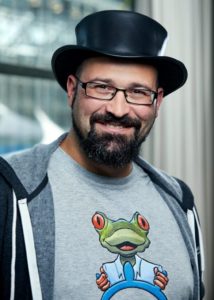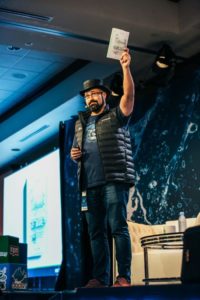Baruch Sadogursky, JFrog, sat down with Kim McMahon, Cloud Native Computing Foundation (CNCF), to talk about cloud native, trends in the industry, and being an Ambassador.

Kim: Thank you Baruch for joining us for the Ambassador interview. Can you introduce yourself?
Baruch: Thank you for having me. I’ve been an Ambassador for the last month and I’m super excited, it’s a huge deal. I’m very proud to be an Ambassador. I’m the Head of Developer Relations at JFrog, a startup company based in Silicon Valley, in Sunnyvale, California. R&D in Israel, India, and all across the world. JFrog does stuff around managing binary files, like universal artifact repository (a.k.a. registry), software composition analysis tool, tools for software distribution and more.
Being the experts in dependency managers and package managers we are helping Helm to raise to an enterprise level. While it’s great as it is, there are some aspects that can be done better, and we are working with the Helm team to improve it. And that’s our main connection to the CNCF projects – we contribute to one of them. I did a CNCF webinar about it not long ago.
Kim: So you live in Silicon Valley now.
Baruch: Yeah, I live in California for the last three years. Before that I lived most of my life, 25 years, in Israel. And I was born and raised in Moscow Russia.
Kim: What do you like to do for fun when you’re not working?
Baruch: I have two kids and we do the normal stuff. We hike, travel, and go places. If I need fun, it is home automation – smart home and stuff. The best thing about this hobby, it costs a lot but it’s not for me. It’s for the home, it’s for the family. It’s like everybody uses it, it’s not mine right? I just improve the home right? That’s how we justify it, but it’s a great hobby.

Kim: What do you see as the next big thing in cloud native, containers, and open source in terms of technology? Where do you see it going next?
Baruch: I think we should start with not trying to predict the future because I personally think we don’t have enough knowledge to make those predictions. Who thought that cloud native would be such a huge thing three years ago? It started with a very limited group of people with strange interests and look where we are now. I feel we don’t have the ability to understand the complexity of that past and make predictions today. But for short term, I think we are on the right track of trying to build this complete landscape of cloud native computing and feel the gaps that we still have.
As our offerings with those projects become more comprehensive and complete, more people in the industry will adopt it. Big data, artificial intelligence – those things happen in the cloud, which requires a lot of computing power and a lot of storage. Another big advantage of the cloud in terms of looking into the future is the frequency and the quality of software updates. And cloud helps with that because it makes the continuous delivery, continuous deployment, and continuous update. The infinite stream like process makes the life of the consumers of the software easier. But also of the producers of the software that need provide those samples.
The ease of manipulating huge amounts of data in very smart ways and the ease of updating the software in the cloud, I think that’s what we will see more in the future. And thank you to Cloud Native Foundation and the projects we have in the Foundation.
Kim: And do you feel that’s what’s driving this higher adoption and getting cloud native enterprise ready where we see more enterprises adopting it?
Baruch: Absolutely, yes. This is exactly the process that we see because it’s the most complete, easy to use, and easy to adopt for massive computing capabilities today. The transition to the cloud wasn’t as rapid as we expected five or eight years ago. But now everything is going to the cloud. It didn’t happen then but it’s happening now more and more.
Some very traditional industries and organizations eventually have come to the cloud because they cannot afford not to. Not because it’s high paying, not because it’s cheaper, but because that’s the only place when they can do what they try to do.
And Cloud Native Foundation today is the stack that people pick. Again, not because people are in love with it and it’s trendy. But because this is an out of the box set of tools and solutions that they hope for.

Kim: One last question, you got a hat. You wear it all the time?
Baruch: I wear it all the time; its part of my personal branding. This and the strange accent and the hard to pronounce name. It all comes together. People will come to our booth and ask for the guy with the hat. It’s all my wife who did my branding. She’s in marketing and I am her pet project of personal branding.
Kim: Well she’s doing a great job! Thank you for joining me.
Baruch: Thank you for having me.